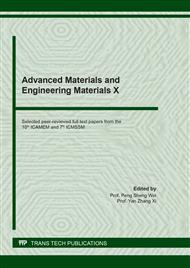[1]
Niraj Nayan, Narayana Murty, Alok Agarwal. Processing and characterization of Al-Cu-Mg alloy rivets for aerospace applications, Materials Science Forum. 2012,710:180-185.
DOI: 10.4028/www.scientific.net/msf.710.180
Google Scholar
[2]
Jiu WenZhang, Marco J Starink, Nong Gao. Influence of Strain Reversals during High Pressure Torsion Process on Strengthening in Al-Cu-Mg(Li) Alloy, Materials Science Forum. 2011,2:809-814.
DOI: 10.4028/www.scientific.net/msf.667-669.809
Google Scholar
[3]
S.K. Ghosh. Influence of Cold Deformation on the Aging Behavior of Al-Cu-Si-Mg Alloy, Journal of Materials Science Technologu. 2011,27(3):193-198.
DOI: 10.1016/s1005-0302(11)60048-0
Google Scholar
[4]
J.M. Minguez, J.Vogwell. Fatigue life of an aerospace aluminum alloy subjected to cold expansion and a cyclic temperature regime, Engineering Failure Analysis. 2006, 6(13):997-1004.
DOI: 10.1016/j.engfailanal.2005.04.005
Google Scholar
[5]
J.Beddoes. Design of solution heat treatments for aerospace alloys, Canadian Metallurgical Quarterly. 2011, 50(3):215-221.
DOI: 10.1179/1879139511y.0000000004
Google Scholar
[6]
K.D. Bouzakis, I.Mirisidis, G.Pantelakis. Fatigue induced alteration of the superficial strength properties of 2024 aluminum alloy, Journal of Materials Science Technology. 2011,27(9):776-784.
DOI: 10.1016/s1005-0302(11)60142-4
Google Scholar
[7]
Huang Lin, Wan Min, Chi Cailou. FEM analysis of spring-backs in age forming of aluminum alloy plates, Chinese Journal of Aeronautics. 2007, 20(6):564-569.
DOI: 10.1016/s1000-9361(07)60083-1
Google Scholar
[8]
Lei Zhang, Xiao Feng, Zhaoguang Li. FEM simulation and experimental study on the quenching residual stress of aluminum alloy 2024, Proceeding of the Insititution of Mechanical Engineers, Part B. Journal of engineering manufacture. 2013,227(7):954-964.
DOI: 10.1177/0954405412465232
Google Scholar
[9]
Hao Zhu, Liang Zhu, Jian-hong Chen. Study of damage mechanism on aluminum alloy under two kinds of stress states and FEM simulation, Key Engineering Materials. 2007,353(2):1157-1160.
DOI: 10.4028/www.scientific.net/kem.353-358.1157
Google Scholar
[10]
B.J. Kim, C.J. Van Tyne, M.Y. Lee. Finite element analysis and experimental confirmation of warm hydroforming process for aluminum alloy, Journal of Materials Processing Technology. 2007,187:296-299.
DOI: 10.1016/j.jmatprotec.2006.11.201
Google Scholar
[11]
Yu Gui-lin. Casting process of hanging rack on aircraft made of high strength aluminum alloyZL205, Materials Engineering. 2001, 1:43-45.
Google Scholar
[12]
Cui Shi-hai, Han Jian-min, Li Wei-jing. Study on corrosion resistance of micro-arc oxidation ceramic coating of high strength casting aluminum alloy, Journal of Aeronautical Materials. 2006,26(2):20-22.
Google Scholar
[13]
Zhu Zhen-feng, Wu Ying-feng, Liu Hui. Template-free synthesis of CdS microspheres by hydrothermal process, Functional Materials. 2013, 17(44):2259-2564.
Google Scholar
[14]
V.R. Skaiskii, I.M. Lyasota. Features of acoustic-emission signals during the initiation of a fatigue failure in a welded joint of an aluminum alloy of the Al-Cu-Mn system, Russian Journal of Nondestructive Testing. 2014,50(2):120-126.
DOI: 10.1134/s1061830914020077
Google Scholar


